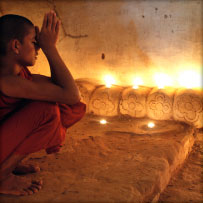Sadhana
Sādhanā (Sanskrit: साधना; Standard Tibetan: སྒྲུབ་ཐབས་, druptap, Wyl. sgrub thabs), literally "a means of accomplishing something", is an ego-transcending spiritual practice. It includes a variety of disciplines in Hindu, Sikh, Buddhist and Muslim traditions that are followed in order to achieve various spiritual or ritual objectives.
Sadhana (Skt. sādhana; Tib. སྒྲུབ་ཐབས་, druptap; Wyl. sgrub thabs) — literally ‘means of accomplishment’. A sadhana is a ritual text presenting the means to accomplish one or several deities, who in essence are the ultimate state of a buddha. As we follow Anuttarayoga Tantra sadhana practice texts and actualize their meaning, we develop an enlightened vision of the world: we visualize ourselves as a buddha or deity, and our surroundings as a pure realm or ‘buddha field’, while recognizing that all sounds are mantra, and all thoughts are primordial wisdom. This process is at first artificial, something which is developed or generated through the practices of kyerim and dzogrim, but the visualizations correspond to the visionary experience of enlightened beings. By adopting these new habits of perception, we can weaken the ordinary habits of gross perception based on ignorance and emotional tendencies, and put ourselves in touch with a more subtle level of experience.
==The Prerequisites of Sadhana Practice==
There are three components needed in order to engage in a specific sadhana practice:
- the empowerment (Tib. དབང་, wang),
- the oral transmission (Tib. ལུང་, lung), and
- the secret instruction (Tib. ཁྲིད་, tri)
which are all granted or bestowed by a qualified master for each specific practice.
- The empowerment or wang is to mature or ripen us.
- The oral transmission or lung is to connect us.
- The secret instruction or tri is to liberate us.
==Types of Sadhana==
In the sadhanas of the outer tantras—kriya tantra, charya tantra or upayoga tantra, and yoga tantra—we invoke the presence of the deity in the sky before us, as in guru yoga. In the sadhanas of the inner tantras—mahayoga, anuyoga, and atiyoga, or the Anuttarayoga Tantra of the Sarma schools—we ourselves arise in the form of the deity.
==Sadhanas Practised by the Rigpa Sangha==
Practices such as: Riwo Sangchö; Tendrel Nyesel; The Wisdom Mind Practice of One Phurba; Dudjom Rinpoche's The Essential Daily Practice of Vajrakilaya; Rigdzin Düpa; Yang Nying Pudri; and Yumka Dechen Gyalmo are all sadhanas.
==Further Reading==
- Padmasambhava & Jamgön Kongtrul, The Light of Wisdom, Vol. Two, translated by Erik Pema Kunsang (Boudhanath: Rangjung Yeshe Publications, 1986-98), Chapters 20-23.
sadhana ("realization"), in Hindu and Buddhist Tantrism, spiritual exercise by which the practitioner evokes a divinity, identifying and absorbing it into himself-the primary form of meditation in the Tantric Buddhism of Tibet. Sadhana involves the body in mudras (sacred gestures), the voice in mantras (sacred utterances), and the mind in the vivid inner visualization of sacred designs and the figures of divinities. Detailed instructions on how the images are to be visualized and the appropriate mantra for each are contained in written sadhanas of most divinities. One such collection is the Sadhanamala (Sanskrit: "Garland of Realization"), composed perhaps between the 5th and the 11th century. This collection of some 300 sadhanas includes those designed for various practical results as well as those intended to further spiritual realization. The written sadhanas also serve to instruct sculptors and painters
The historian N. Bhattacharyya provides a working definition of the benefits of sādhanā as follows:
... religious sādhanā, which both prevents an excess of worldliness and molds the mind and disposition (bhāva) into a form which develops the knowledge of dispassion and non-attachment. Sādhanā is a means whereby bondage becomes liberation.
Iyengar (1993: p. 22) in his English translation of and commentary to the Yoga Sutras of Patanjali's defines sādhanā in relation to abhyāsa and kriyā:
Sādhanā is a discipline undertaken in the pursuit of a goal. Abhyāsa is repeated practice performed with observation and reflection. Kriyā, or action, also implies perfect execution with study and investigation. Therefore, sādhanā, abhyāsa, and kriyā all mean one and the same thing. A sādhaka, or practitioner, is one who skillfully applies...mind and intelligence in practice towards a spiritual goal.
Meditational practice, normally involving visualization, recitation of verses and mantras, physical gestures, and real or visualized offerings to a particular YIDAM, in order to attain ENLIGHTENMENT or other supernatural power (see SIDDHI)
Paths
The term " sādhanā" means spiritual exertion towards an intended goal. A person undertaking such a practice is known as a sādhu or a sādhaka. The goal of sādhanā is to attain some level of spiritual realization, which can be either enlightenment, pure love of God (prema), liberation (moksha) from the cycle of birth and death (saṃsāra), or a particular goal such as the blessings of a deity as in the Bhakti traditions.
Sādhanā can involve meditation, chanting of mantra (sometimes with the help of a japa mala), puja to a deity, yajna, and in very rare cases mortification of the flesh or tantric practices such as performing one's particular sādhanā within a cremation ground.
Anthony de Mello, an Indian orphan who became a Jesuit priest and founder of the Sadhana Institute in Pune, India, wrote a book of Christian meditations with the title Sadhana: A way to God.
Traditionally in some Hindu and Buddhist traditions in order to embark on a specific path of sādhanā, firstly a guru may be required to give the necessary instructions. This approach is typified by some Tantric traditions, in which initiation by a guru is sometimes identified as a specific stage of sādhanā'. On the other hand, individual renunciates may develop their own spiritual practice without participating in organized groups.
Kinds
Sādhanā or spiritual practice need not be directed towards a higher cause like enlightenment or moksha. Sādhanā can be done by individuals for lower aims like obtaining worldly pleasures. Sādhanā is also done by a group for the society at large.
Sakām sādhanā
Sakām sādhanā (Devanagari सकाम, sa = yes / with, kām = desire) is spiritual practice done for worldly pleasures. This is the lowest form of sādhanā. There is no spiritual progress with sakām sādhanā. Examples of sakām sādhanā are praying for any worldly goals like getting money, a job, marriage or any other aim which are temporary and will not last beyond death. In Ramayana it was mentioned that though Ravana and Kumbhakarna were great devotees of Shiva and performed various tapas, they were performing sakām sādhanā as their main aim was to become powerful and rule the world, but in happiness and peace.
The fruits of this kind of spiritual practice are used to fulfill the worldy desires of the individual and no spiritual progress takes place. Thus it is not possible to reach enlightenment, moksha or even heaven as the merits needed to achieve this are used up. sakām sādhanā .
Niṣkām sādhanā
Niṣkām (Devnagari = निष्काम, niṣ = no / without, kām = desire) sādhanā is spiritual practice done for higher aims. It is done to achieve the aim of enlightenment or moksha. It is done for the spiritual upliftment of the individual so that he is taken out of the cycle of life and death (saṃsāra).
Vyaṣṭi sādhanā
This is niṣkām sādhanā done for one's own spiritual upliftment. No one else is benefitted except the person doing vyaṣṭi sādhanā. Thus this form of spiritual practice is an individualistic practice. This form of sādhanā is very important if one wants to do samaṣṭi sādhanā.
Examples of vyaṣṭi sādhanā
Chanting God's name (nāmjap)
Meditation
Karmayoga
Hathayoga
Reading books on Spirituality
Benefits of vyaṣṭi sādhanā
Spiritual Progress
Increase in Sātvikta
Increases Bhaava (Faith)
Increases the talmal (desire for God)
Lower level Anubhuti (spiritual experiences)
Pitfalls of vyaṣṭi sādhanā
Note: These pitfalls exist if the sādhanā is done without a guru and if not accompanied by samaṣṭi sādhanā.
Ego can increase
Needs a lot of time for little spiritual progress
One can lose motivation as fast progress is not achieved
Samaṣṭi sādhanā
This is the kind of niṣkām sādhanā which is done collectively for the spiritual progress of entire humanity. It is the highest level of sādhanā. For samaṣṭi sādhanā to be maintained, vyaṣṭi sādhanā is a must. The same logic that a teacher must read the book first before teaching the students can be applied to this. In Kali Yuga, samaṣṭi sādhanā is important as the people do not know the significance of sādhanā. This kind of sādhanā is more difficult and increases the sātvikta of the entire area. Samaṣṭi sādhanā is not possible without a guru.
Examples of samaṣṭi sādhanā
Taking satsangs
Helping in organising satsangs, meditation camps, etc.
Telling others about spirituality.
Helping others overcome ego by telling them their mistakes from the point of view of spirituality.
Benefits of samaṣṭi sādhanā
Samaṣṭi level sādhanā is more difficult compared to vyaṣṭi but it has added benefits.
We become closer to God
Faster Spiritual progress
Love for all living beings (prīti) increases
Superior level spiritual experiences (anubhutis)
After death we go to higher planes of existence (svarga or heaven and beyond)
Ego and Personality Defects can be easily removed
Movement from saguna to nirguna
Pitfalls of samaṣṭi sādhanā
More energy is required (physical, mental and spiritual)
Attitude is important
More chances of ego increasing
Very important to do samaṣṭi sādhanā under correct guru.
One mistake in samaṣṭi sādhanā has a cascading effect and many are affected. This increases the sin of the person who made the mistake.
Tantric sādhanā
The tantric rituals are called "sādhanā". Some of the well known sādhanās are:
śāva sādhanā (sādhanā done sitting on a corpse).
śmaśāna sādhanā (sādhanā done in the cremation ground).
pañca-muṇḍa sādhanā (sādhanā done sitting on a seat of five skulls).
Buddhism
In the Vajrayāna Buddhism of Tibet and East Asia and following the Nalanda tradition of India-Tibet-China, there are fifteen major tantric sādhanas:
1. Śūraṅgama Sitātapatrā,
2. Nīlakaṇṭha,
3. Tārā,
4. Mahākāla,
5. Hayagrīva,
6. Amitābha Amitāyus,
7. Bhaiṣajyaguru Akṣobhya,
8. Guhyasamaja,
9. Vajrayoginī Vajravarāhi,
10. Heruka Cakrasaṃvara,
11. Yamāntaka Vajrabhairava,
12. Kālacakra,
13. Hevajra
14. Chod,
15. Vajrapāṇi.
All of these are available in Tibetan form, many are available in Chinese and some are still extant in ancient Sanskrit manuscripts.
In the sādhana of Buddhism and Vajrayāna in particular, the upāya of the dedication of merit (Sanskrit: pariṇāmanā) is a component.
Kværne (1975: p. 164) in his extended discussion of sahajā, treats the relationship of sādhana to mandala thus:
...external ritual and internal sadhana form an indistinguishable whole, and this unity finds its most pregnant expression in the form of the mandala, the sacred enclosure consisting of concentric squares and circles drawn on the ground and representing that adamantine plane of being on which the aspirant to Buddhahood wishes to establish himself. The unfolding of the tantric ritual depends on the mandala; and where a material mandala is not employed, the adept proceeds to construct one mentally in the course of his meditation.
—
Islam
This section does not cite any references or sources. Please help improve this section by adding citations to reliable sources. Unsourced material may be challenged and removed. (September 2012)
Islam itself could be understood as a "sadhana". Some more specialized practices include dhikr and chilla-nashini as well as the way of self chosen poverty as a derwish or mendicant as well as the Sama (Sufism) of the various Sufi orders.
Meher Baba's teachings
The spiritual teacher Meher Baba stated that one participates in part of the goal of sadhana in the spiritual practice itself: "In the spiritual field it is not possible to maintain an unbridgeable gulf between Sadhana and the end sought through it. This gives rise to the fundamental paradox that, in the spiritual field, the practising of a Sadhana in itself amounts to a partial participation in the goal." According to Baba, the goal of sadhana is God-realization: "It aims at bringing about a radical change in the quality of life so that it permanently becomes an expression of the Truth in the eternal NOW. Sadhana is spiritually fruitful if it succeeds in bringing the life of the individual in tune with the divine purpose, which is to enable everyone to enjoy consciously the God-state."
Sādhaka
A sādhaka is a practitioner of a particular sādhanā. The term "sādhaka" is often synonymous with "yogini" or "yogi".






